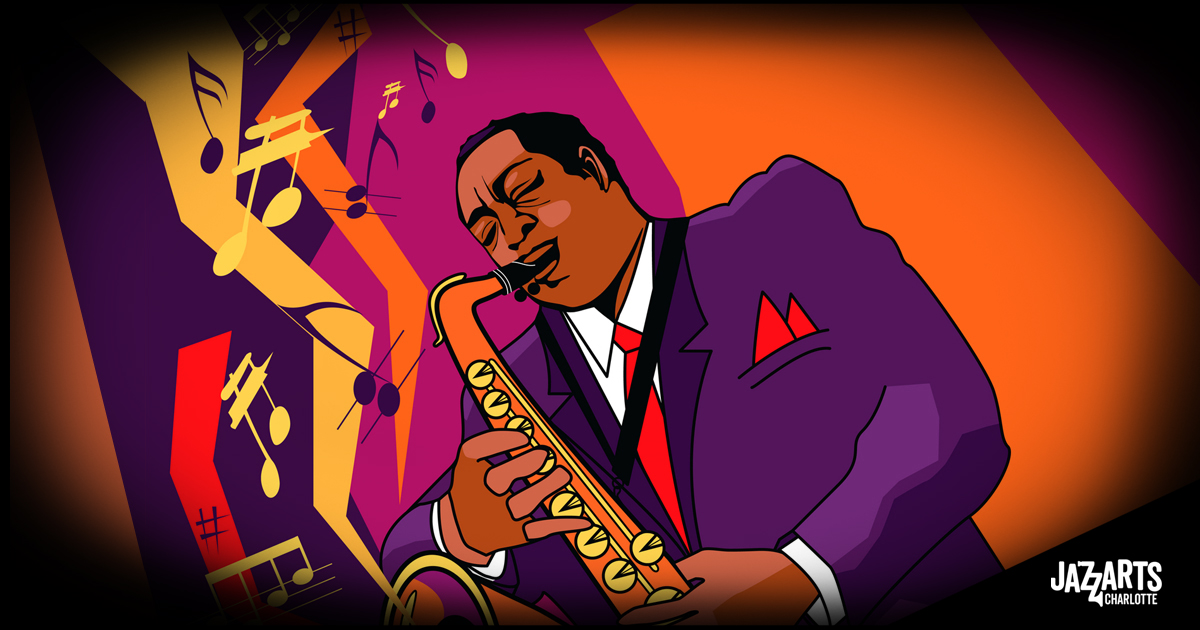
Jazz History is America’s History
Written by Dr. Kelsey Klotz, Musicologist and lecturer in UNC Charlotte’s Department of Music, and JazzArts Charlotte instructor for the favorite virtual “Jazz Appreciation” series.
Most people start jazz’s timeline in 1917 with the Original Dixieland Jazz Band’s recording of “Livery Stable Blues,” considered to be the first jazz recording. From that point on, jazz is present in every major moment of American history: From the exuberance of the Roaring Twenties to the escapism of the Great Depression, from USO shows and Victory discs to support World War II soldiers to jazz ambassadors sent abroad during the Cold War, from jazz musicians protesting for civil rights to protests against the Vietnam War, from the expansion of jazz programs with the growth of college enrollments to the psychedelics and Afro-futurism of the 1970s, from the birth of MTV to the simultaneous conservative retrenchment in the 1980s, from jazz’s institutionalization in the 1990s and 2000s to its #Blacklivesmatter and #metoo moments—jazz, its audiences, and its performers, have accompanied, reflected, and informed every historical moment of the past 100 years.
Follow along with this playlist to understand how jazz musicians have not only reflected America’s history back, but have found and performed its best qualities—the qualities toward which the country constantly strives. Throughout, they demonstrate again and again that jazz cannot be separated from American history.
Jazz musicians have constantly demonstrated their immense virtuosity, reflecting the promise of American musical expertise and performance, such as in Louis Armstrong’s magnificent shift toward solo improvisation in the 1920s; in Art Tatum’s piano performances, which defy the laws of what two hands are capable of doing alone; Dizzy Gillespie and Charlie Parker’s high-flying, speeding bebop lines; Marian McPartland’s ability to play with wide-ranging musicians in each and every jazz genre; and Django Reinhardt’s amazing facility on the guitar despite an injury that made him unable to use his fourth and fifth fingers.
Jazz musicians have shown what collaboration can create, combining countless musical talents, such as in the 1957 CBS taping of “Fine and Mellow,” featuring Billie Holiday, Ben Webster, Lester Young, Gerry Mulligan, Coleman Hawkins, Roy Eldridge, and others, or in Esperanza Spalding’s 2017 “Exposure,” written, rehearsed, and recorded live on Facebook, and featuring Robert Glasper (other tracks feature musicians like Andrew Bird and Lalah Hathaway). At the same time, a competitive spirit often drives musicians to push one another toward excellence in what are called cutting contests—a musical battle between musicians meant to allow one to claim musical and technical superiority over the other—such as Dexter Gordon and Wardell Gray’s “The Chase.” (Cutting contests were especially popular among stride pianists like James P. Johnson and Fats Waller in live performance.)
Jazz has given us a language for love and joy—whether that love is tender, like Miles Davis’s “My Funny Valentine” or Sarah Vaughan’s “Misty,” or if that joy is exuberant and persistent, like Nina Simone’s “Young, Gifted and Black,” or if that joy just needs to get danced out, as in Weather Report’s “Birdland.” And jazz can make us laugh: just listen to Ella Fitzgerald’s “Mack the Knife” for a masterclass in virtuosity, showmanship, and fun.
Jazz musicians have prayed with us and for us: John Coltrane’s A Love Supreme (1964) showed audiences the spiritual, non-denominational capacity for jazz expression, which Alice Coltrane and Pharoah Sanders followed up with in work like Journey in Satchidananda (1970) and Black Unity (1971). They have also connected with us in religious devotion, such as in Mary Lou Williams’s Black Christ of the Andes (1964), which incorporates spirituals, blues, and avant-garde jazz to honor the Catholic Peruvian Saint Martin de Porres.
Jazz musicians have shown us the future, and imagined futures for us—check out Sun Ra and His Arkestra’s science fiction and Egyptian symbol-inspired performances and future-focused avant garde sounds (reflecting Sun Ra’s experience of being teleported to Saturn and being delivered a message—that he would speak and the world would listen). Esperanza Spalding imagines new spaces, personalities, and spirits, using jazz as only one way of expressing boundless possibilities for the future.
Jazz musicians have constantly reached out beyond borders: Some have worked in aid of the American government, as was the case with cultural ambassadors like Dizzy Gillespie, Dave Brubeck, Benny Goodman, and more during the Cold War. Others have reached toward America, such as Antônio Carlos Jobim and João Gilberto’s nearly instantly popular bossa nova genre, which many jazz musicians, including Stan Getz, immediately took a shine to. Still others, like Josephine Baker, became expatriates, seeking respite in Europe from the daily discriminations of Jim Crow-era America.
Jazz musicians have pushed the boundaries of what could be called jazz—or even what could be called music. They innovated new musical forms, like when Ornette Coleman and others explored free jazz, or when Miles Davis experimented with fusion and production techniques in Bitches Brew, or when Herbie Hancock’s combined jazz and hip hop in “Rockit,” which won Grammy and MTV awards and paved the way for more Black artists to be featured on MTV. Still others have kept the music alive by focusing on tradition, like “Sweet” Emma Barrett, who continued the Dixieland style well into the 1960s, and Wynton Marsalis, whose Jazz at Lincoln Center frequently celebrates and honors the history of jazz.
Throughout history and to the present-day, jazz has reflected America’s best promises and potential. But it also has at times reflected its worst mistakes, moments when it has not lived up to its own ideals—moments of pain, oppression, and rejection.
Jazz musicians have been direct—sometimes painfully so—about the weight of American history and experience. For example, Billie Holiday made famous the anti-lynching song “Strange Fruit.” She first recorded it in 1939, and continued to perform it throughout her life, working harder and harder every time to connect audiences to the song’s depictions of pain and oppression. Much of Nina Simone’s work sought to draw attention to discrimination during the civil rights movement, ranging from upbeat show tunes like “Mississippi Goddam” to the somber ballad “Why? (The King of Love is Dead),” written after the assassination of Martin Luther King, Jr. Louis Armstrong used a performance of “Black and Blue” to connect with and calm enthusiastic audiences in Ghana, protecting them from police officers eager to break up the crowd more violently. And some, like trombonist and arranger Melba Liston, had to step away for years at a time to take a rest from the discriminations and abuses she experienced as a Black woman in jazz, before being pulled back into jazz’s orbit yet again.
Still others have, in Dizzy Gillespie’s words, “grinned in the face of racism,” like Louis Armstrong’s boisterous performances of “Mack the Knife,” or Duke Ellington’s “It Don’t Mean A Thing (If It Ain’t Got That Swing).”
Jazz musicians have been thoughtful and deeply intellectual about their place in American history: Duke Ellington’s landmark suite Black Brown and Beige (1943) was dedicated to the more than 700 Black people who came from Haiti to save Savannah during the Revolutionary War in 1779. Max Roach charted the course of Black history from slavery, through the Emancipation Proclamation, and the African independence movements of the 1950s in We Insist! Freedom Now Suite (1960), which prominently featured Abbey Lincoln as the voice of struggle, matching thoughtfulness with anger.
And musicians have taken steps to address such systemic injustices: this is most recently evidenced in Terri Lyne Carrington’s New Standards, vol. 1 project, which collects and records jazz standards by women to promote gender equity in a jazz field historically dominated by male musicians.
Jazz history is America’s history. If we accept jazz—if we love it—then we love all of it, even the parts we don’t like, the parts we wish would be different. We recognize the songs as gifts, and the musicians as gift bearers. We listen to the stories they have to tell, and we learn from them. In doing so, we can bear witness to the strength of jazz’s future; for if jazz is America’s history, let it also be America’s future.
